Home >>> Landscaping >> Integrated Pest Management
Integrated Pest Management
The pressures of maintaining a perfect yard have forced people to "over-maintain" their landscapes. Over-watering and over-fertilizing can cause excessive plant growth and improper mowing and pruning weakens plants and grass, leaving them prone to pest damage.
Blanket pesticide application has become the quick-fix norm for lawn maintenance. But the use of pesticides and insecticides is a one-dimensional approach to pest management, resulting in environmental contamination, pest resistance, and the destruction of beneficial insects.
The environmentally sound alternative to pesticide use is a combination of pest control strategies known as Integrated Pest Management (IPM). IPM promotes the use of the least toxic method of pest control, the use of pest-resistant plants, and the natural enemies of pests.
IPM utilizes 5 components to reduce the risk of exposure of harmful pesticides to people, animals, and the environment:
- Cultural component—the proper selection and maintenance (mowing, pruning, and irrigation) of your lawn and landscape plants. Keeping landscapes healthy reduces susceptibility to disease and reduces the need for chemical treatment.
- Biological component—the release and/or conservation
of natural enemies and beneficial organisms. Natural enemies (such
as ladybugs or mantids) can be purchased and released in pest-infested
landscapes. Landscapes can also be designed to provide habitat for
natural enemies.
Meet the good guys! These beneficial insects help keep pest populations under control.
Work with nature! Planting a variety of flowering plants in your landscape can increase the population of beneficial insects that eats the harmful insects. - Genetic component—the breeding of grasses and plants that are resistant to key pests. When designing a landscape, the selection of resistant plant species is an integral part of IPM. Talk to a nursery specialist for more information about such plants.
- Chemical controls—when chemicals are necessary,
choose a newer, more selective chemical such as a microbial insecticide
or insect growth regulator. Be sure to read all labels carefully and
follow the directions for proper application.
- Spot treat
When chemical treatment is necessary, be sure to just treat the affected plant or area. Indiscriminantly using chemicals is wasteful, increases the amount of run-off, and kills both pests and beneficial organisms. Following pesticide application, beneficial insect populations are slow to rebuild. - Try soap and water first
Mix 2 ½ tablespoons of liquid dish soap with 1 gallon of water in a spray bottle. Spray liberally onto affected plants and reapply if necessary. For more home recipes for pest control, check out Home IPM Alternatives.
- Spot treat
- Pest monitoring—understand the lifecycle
of a pest and know which plants and conditions it prefers.
- Check your plants regularly
Make it a habit to walk around your yard every 2 weeks and look closely at your plants. Identify pests and spot treat when necessary. - Treat problems early
The early stages of insect infestations can be hand picked or pruned. Consult the Florida Yards and Neighborhoods handbook for a list of Common Plant Pests and Least Toxic Controls. (page 71)
- Check your plants regularly
If you use a lawn-care service or pest control company be sure to talk to them! Ask them for advance notice and permission for chemicals to be sprayed near your home. Always ask if safer alternatives are available.
Common Florida Pest Insects
Florida’s
warm and humid climate creates a breeding ground for many pest
insects. Although annoying, they provide food for other insects
and animals. Be sure to use the least toxic method of pest management
when dealing with them. |
|
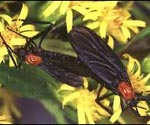 |
Love bugs. Although not native to Florida, these insects swarm the roadways twice a year, usually in May and September. Both sexes of the small black and red insects sit, crawl, and fly end-to-end during the prolonged mating bout. Least toxic control: Bugs should be washed off cars as soon as possible to prevent paint damage. |
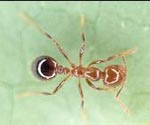 |
Fire ants. Florida hosts the imported fire ant that came from South America. Their irregular sandy mounds can be up to 3 feet across and 2 feet high. Fire ants are aggressive defenders so treat them with caution! Least toxic control: no control method permanently eliminates fire ants. Non-chemical controls include pouring hot water or a water and soap solution over mounds. Chemical controls include baits found in stores. |
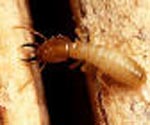 |
Termites. These soft-bodied insects live in colonies that house hundreds to thousands of individuals hidden in tunnels and burrows inside wood or in the soil beneath rotting wood. Termites chew and swallow wood but cannot digest it. Instead, microscopic organisms in their guts break down the wood into basic nutrients the termites can absorb. Least toxic control: above ground or in-ground baits. Baiting is a hit-or-miss process because the termites must find the baits themselves. If problems persist, contact a termite control specialist. |
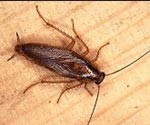 |
|
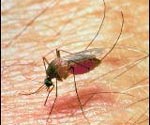 |
Mosquitoes.
Florida hosts 69 species of mosquitoes. Hatching from tiny eggs
laid in standing water, only the females suck blood in order to
produce eggs. They fly most often when the air is moist because
hot air dries out their small bodies. Fortunately many other animals
eat mosquitoes including birds, spiders, and fish. Least toxic
control: Prevention begins with sanitation and elimination
of breeding sites. Clean debris from rain gutters, eliminate standing
water, and clean out birdbaths and pet dishes often. |

